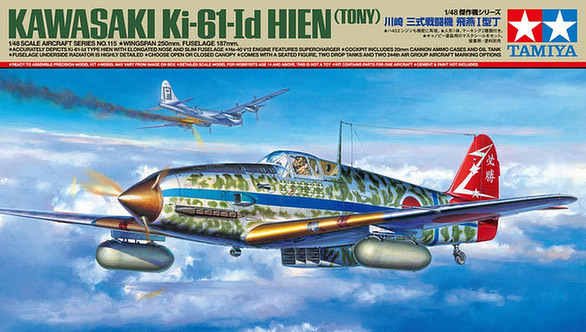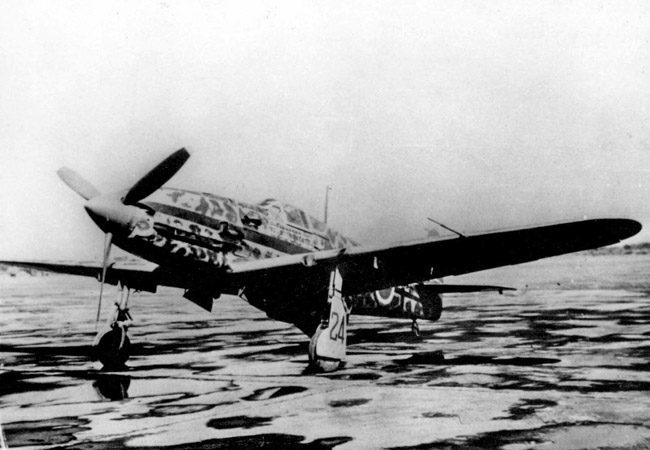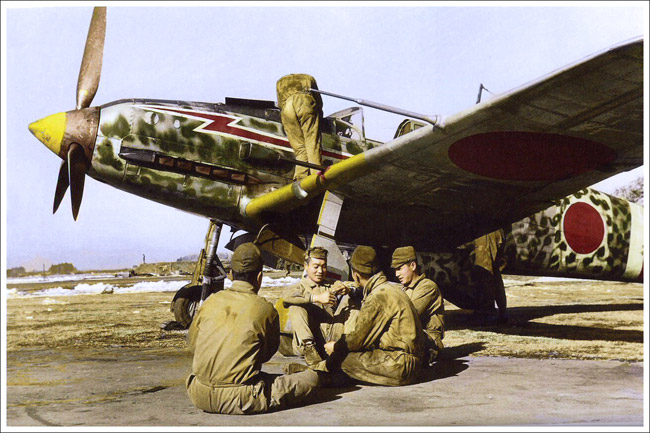
Full review by Dave Coward
The kit
For a full review of what you get in the box have a look at the Tamiya Kawasaki Ki-61Id Hien (Tony) 1:48 In-Box review from Geoff.
Aftermarket Extras:
Eduard Japanese pre-painted seat belts
Background


(Courtesy of Wikipedia)
The Kawasaki Ki-61 Hien (飛燕, “flying swallow”) is a Japanese World War II fighter aircraft used by the Imperial Japanese Army Air Service. The Japanese Army designation was “Army Type 3 Fighter” (三式戦闘機). Allied pilots initially believed Ki-61s were Messerschmitt Bf 109s and later an Italian aircraft, which led to the Allied reporting name of “Tony”, assigned by the United States War Department. It was the only mass-produced Japanese fighter of the war to use a liquid-cooled inline V engine. Over 3,000 Ki-61s were produced. Initial prototypes saw action over Yokohama during the Doolittle Raid on 18 April 1942, and continued to fly combat missions throughout the war.
Design and Development
The Ki-61 was designed by Takeo Doi and his deputy Shin Owada in response to a late 1939 tender by the Koku Hombu for two fighters, each to be built around the Daimler-Benz DB 601Aa. Production aircraft would use a Kawasaki licensed DB 601, known as the Ha-40, which was to be manufactured at its Akashi plant. The Ki-60 was to be a heavily armed specialised interceptor, with a high wing loading; the Ki-61 was to be a more lightly loaded and armed general-purpose fighter, intended to be used mainly in an offensive, air superiority role at low to medium altitudes.
Both single-seat, single-engine fighters used the same basic construction, being of all-metal alloys with semi-monocoque fuselages and three-spar wings, with alloy-framed, fabric-covered ailerons, elevators and rudders. Priority was given to the Ki-60, which first flew in April 1941, while design work on the Ki-61 did not begin until December 1940. Although the Ki-61 was broadly similar to the Ki-60, it featured several refinements exploiting lessons learned from the disappointing flight characteristics of the earlier design.
The all-metal, semi-monocoque fuselage was basically oval in cross-section, changing to a tapered, semi-triangular oval behind the cockpit canopy, with a maximum depth of 1.35 m (4 ft 5 in). An unusual feature of the Ki-61 was that the engine bearers were constructed as an integral part of the forward fuselage, with the cowling side panels being fixed. For servicing or replacement, only the top and bottom cowling panels could be removed. A tapered, rectangular supercharger air intake was located on the port-side cowling. Behind the engine bulkhead were the ammunition boxes feeding a pair of synchronized 12.7 mm (.50 in) Ho-103 machine guns which were set in a “staggered” configuration (the port weapon slightly further forward than that to starboard) in a bay just above and behind the engine. The breeches partly projected into the cockpit, above the instrument panel. The Ho-103 was a light weapon for its calibre (around 23 kg/51 lb) and fired a light shell, but this was compensated for by its rapid rate of fire. The ammunition capacity was limited, having only around 250 rounds for each weapon. A self-sealing fuel tank with a capacity of 165 L (44 US gal) was located behind the pilot’s seat. The windshield was armoured and there was a 13 mm (.51 in) armour plate behind the pilot. The radiator and oil cooler for the liquid-cooled engine were in a ventral location below the fuselage and wing trailing edge, covered by a rectangular section fairing with a large, adjustable exit flap.
The evenly-tapered wings had an aspect ratio of 7.2 with a gross area of 20 m² (215.28 ft²) and featured three spars; a Warren truss main spar and two auxiliary spars. The rear spar carried the split flaps and long, narrow-chord ailerons, while the front spar incorporated the undercarriage pivot points. The undercarriage track was relatively wide at 4 m (13 ft 1.5 in). Each wing had a partially self-sealing 190 L (50 US gal) fuel tank behind the main spar, just outboard of the fuselage. A single weapon (initially a 7.7 mm/0.303 in Type 89 machine gun) was able to be carried in a weapons bay located behind the main spar.
The first prototype of the San-shiki-Sentohki ichi gata (“Type 3 Fighter, Model 1”, the official IJAAF designation) first flew in December 1941 at Kagamigahara Airfield. Although test pilots were enthusiastic about its self-sealing fuel tanks, upgraded armament, and good dive performance, the wing loading of 146.3 kg/m² (30 lb/ft²) at an all-up weight of 2,950 kg (6,500 lb) was viewed with scepticism by many of the senior officers of the Koku Hombu, who still believed in the light, highly manoeuvrable, lightly armed fighter epitomised by the then new Nakajima Ki-43-I-Hei which had a wing loading of 92.6 kg/m² (19 lb/ft²) (and even that was considered borderline compared to the earlier Ki-27).
To address these concerns, Kawasaki staged a fly-off between two Ki-61 prototypes and the Nakajima Ki-43-I, a pre-production Nakajima Ki-44-I, a defector-flown Lavochkin-Gorbunov-Goudkov LaGG-3, a Messerschmitt Bf 109E-7, and a captured Curtiss P-40E Warhawk. The Ki-61 proved the fastest of all the aircraft and was inferior only to the Ki-43 in manoeuvrability.
The Ki-61 was the last of the fighters powered by the DB-601 or its foreign derivatives, and it was soon overshadowed by fighters with more powerful engines. By the time it first flew in December 1941, one year after the Macchi C.202’s first flight and three years after the first Bf 109E, the engine was already underpowered compared to the new 1,120 kW (1,500 hp) inline or 1,491 kW (2,000 hp) radial engines being developed (and already nearing the mass-production stage) to power the next generation of combat aircraft such as the Republic P-47 Thunderbolt. Moreover, the inline Ha-40 engine proved to be an unreliable powerplant.
The DB-601 engine required precise and sophisticated manufacturing; the Ha-40 was lighter by roughly 30 kg (70 lb) and required even higher manufacturing standards. Reaching these standards proved difficult for Japanese manufacturers, an issue further complicated by the variable quality of materials, fuel, and the lubricants needed to run a sensitive, high-performance engine. The Japanese equivalent of the more powerful DB-605 engine was the Ha-140, which was fitted onto the Type 3 to produce the Ki-61-II high-altitude interceptor.
Compared to the Ki-61-I, the Ki-61-II had 10% greater wing area, used more armour and was powered by the Kawasaki Ha-140 engine generating 1,120 kW (1,500 hp). After overcoming initial fuselage and wing stability problems, the new interceptor reverted to the original wing and was put into service as the Ki-61-II-KAI. However, the Ha-140 engine had severe reliability problems which were never fully resolved, and around half of the first batch of engines delivered were returned to the factory to be re-built. A US bombing raid on 19 January 1945 destroyed the engine factory in Akashi, Hyōgo, and 275 Ki-61-II-KAI airframes without engines were converted to use the Mitsubishi Ha-112-II radial engine, resulting in the Ki-100. While the Ha-112 solved the problems encountered with the Ha-140, the new engine still had a major weakness: a lack of power at altitude, which diminished its ability to intercept high-flying B-29 Superfortresses relative to the Ki-61-II.
During testing, the Hien proved capable, but several shortcomings were subsequently revealed in operational service, namely the armour protection that was insufficient against larger guns and a sub-standard engine that eventually led to a new engine being considered.
Operational History
The Ki-61 looked so different to the usual radial-engined Japanese fighters that the Allies at first believed it to be of German or Italian origin, possibly a license-built Messerschmitt Bf 109. The first Ki-61 seen by Allied aircrew had been misidentified as a Bf 109 by USAAF Capt. C. Ross Greening during the Doolittle Raid. In early reports, when it was thought to have been a German fighter, the Ki-61 had been code-named “Mike”. The final, and better known code name adopted was “Tony”, because the Ki-61 looked like an Italian aircraft.
The new Ki-61 Hien fighters entered service with a special training unit, the 23rd Chutai, and entered combat for first time in early 1943, during the New Guinea campaign. The first Sentai (Air Group/Wing) fully equipped with the Hien was the 68th in Wewak, New Guinea, followed by the 78th Sentai stationed at Rabaul. Both units were sent into a difficult theatre where jungles and adverse weather conditions, coupled with a lack of spares, quickly undermined the efficiency of both men and machines. Because the Ki-61 was so new, and had been rushed into service, it inevitably suffered from teething problems. Almost all of the modern Japanese aircraft engines, especially the Ki-61’s liquid-cooled engines, suffered a disastrous series of failures and ongoing problems, which resulted in the obsolescent Ki-43 still forming the bulk of the JAAF’s fighter capability.
Initially, this campaign went successfully for the Japanese Army Air Force (JAAF), but when the Allies re-organised and enhanced the combat capabilities of their air forces, they gained the upper hand against the JAAF. High non-combat losses were also experienced by the Japanese during this campaign. For example, while in transit between Truk and Rabaul, the 78th lost 18 of its 30 Ki-61s.
Even with these problems, there was some concern in Allied aviation circles regarding the Hien…
The new Japanese fighter caused some pain and consternation among Allied pilots, particularly when they found out the hard way that they could no longer go into a dive and escape as they had from lighter Japanese fighters. …General George Kenney [Allied air forces commander in the Southwest Pacific] found his Curtiss P-40s completely outclassed, and begged for more Lockheed P-38 Lightnings to counter the threat of the new enemy fighter.
However, the increasing numerical strength of Allied bomber units, along with inadequate anti-aircraft systems, imposed crippling losses on Japanese units. Approximately 100 out of 130 Japanese aircraft based in the Wewak area were lost during the attacks of August 17–21 1943. By the end of the campaign, nearly 2,000 Japanese aircraft had been lost in air attacks from up to 200 Allied aircraft at a time, around half of which were Consolidated B-24 Liberators and North American B-25 Mitchells armed with fragmentation bombs. After the Japanese retreat, over 340 aircraft wrecks were later found at Hollandia.
The Ki-61 was also utilised in Southeast Asia, Okinawa, China and as an interceptor during US bombing raids over Japanese home islands, including against Boeing B-29 Superfortresses.
A number of Ki-61s were also used in Tokkotai (kamikaze) missions launched toward the end of the war. The Ki-61 was delivered to 15th Sentai (group/wing), as well as some individual Chutaicho (junior operational commanders) in other Sentai, and even to operational training units in the JAAF. The aircraft was largely trouble-free in service except for the liquid-cooled engine which tended to overheat when idling on the ground and suffered from oil circulation and bearing problems.
Ki-61 Special Attack Unit
The tactic of using aircraft to ram American Boeing B-29 Superfortresses was first recorded in late August 1944, when B-29s from Chinese airfields attempted to bomb the steel factories at Yawata. Sergeant Shigeo Nobe of the 4th Sentai intentionally flew his Kawasaki Ki-45 into a B-29; debris from the explosion severely damaged another B-29, which also went down. Other attacks of this nature followed, as a result of which individual pilots determined it was a practicable way of destroying B-29s.
On 7 November 1944, the officer commanding the 10th Hiko Shidan (Air division) made ramming attacks a matter of policy by forming ramming attack flights specifically to oppose the B-29s at high altitude. The aircraft were stripped of their fuselage armament and protective systems in order to attain the required altitudes. Although the term “kamikaze” is often used to refer to the pilots undertaking these attacks, the word was not used by the Japanese military.
Construction
Three things are certain in life; taxes, death and Tamiya kits fitting well, so this being Tamiya’s latest offering I’m hoping for a nice hassle-free build but also, I’m looking forward to the painting stage as I want to try out that unique mottle scheme that is shown on the box front. Apart from the above listed Eduard seat belts I intend to build the kit pretty much from the box so let’s see how it goes together.